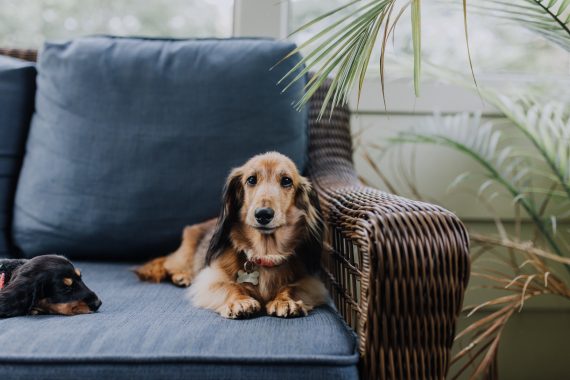A Guide to Exercising Your Dog at Home

Exercising your dog at home isn’t as difficult as you might think.
Walking your dog daily is important, however, if you are unable to take the dog out for a long walk, there are alternative exercises at home that can still be effective. Here are some tips on how to exercise your dogs at home.
Make use of the stairs
If you have stairs make the most of them. Using the stairs is a great way to tire out your dog and release pent up energy. The steps add an additional challenge to the workout and use different muscles to those usually being worked during walking due to the change in elevation. Stand at the top of the stairs with your dog, throw a toy down for them to fetch. Once they are at the bottom of the stairs, call their name to have them return the toy. Repeat this a few times for maximum effect.
Be aware that this exercise is not suitable for some dogs. If your dog is older, has existing health issues or has arthritis then avoid this exercise completely.
Set up your own obstacle course
This one takes a little bit of creativity but can be a lot of fun. Find everyday objects around the house or garden that can be used to create an obstacle course. Use cushions and pillows to create tunnels and paths for the dog to navigate. Use paddling pools, hula hoops and more to create various obstacles and challenges. Slowly walk your dog through the obstacle course first so that they get used to the course. Then you can repeat. This is a great way to have fun with your dog, whilst also challenging them physically and mentally
Make them work for their treats
Take a variety of your dog’s favourite treats and hide them around the house to create a scavenger hunt. Place some in easy places to start with and then get increasingly difficult. Your dog’s natural hunting instincts will kick in during this game. Not only will it help tire them out physically, but it also provides them with a mental challenge. Treat dispensing toys are another great way to do this. They keep your dog busy and engaged whilst they try to get to the treats inside.
Play hide and Seek
You can also play hide and seek along with your dog. This is especially fun when there are a couple of people playing. Tell your dog to sit whilst you go and hide. One of you then calls their name so the dog will come and find them. Not only is this fun for the dog, but it also helps keep them busy and active. Hide and seek is a great way of exercising your dog at home, and it is a perfect bonding exercise as well.
Keep them interested
One thing that is sometimes difficult whilst exercising your dog at home is keeping them interested and ensure they do not get bored. Getting some news toys can always help as dogs tend to get excited when they are given something new to play with. It is unrealistic to keep buying new things all the time though. Therefore, an alternative option is to rotate the toys your dog has access to. Choose a few toys at a time, and place the others somewhere the dog cannot get to. This will help keep your dog interested and avoid them from getting bored with particular toys.
Just remember, that you are in control of how long your dog engages in indoor play. Although exercise is extremely beneficial, your dog needs limitations, so ensure you are keeping track of how much exercise your dog is doing and ensure that they are not overexerting themselves and are still getting sufficient rest.
Also, remember that the exercises above are sometimes not suitable for all dogs. Each dog is individual and some of these exercises may not be appropriate for them. Always use your best judgement before choosing your exercise. Be considerate of your surroundings as well. For example, if you live in an apartment, some of these exercises will not work.
So, if the weather conditions are too severe, or you cannot leave the house, bear these exercises in mind as they are all great ways to ensure that your dog is being stimulated both physically and mentally.
For advice on dog care, training, behaviour therapy and more, please visit our articles page which is full of free advice.